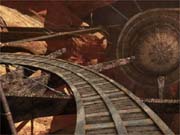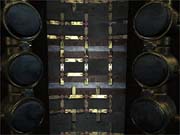What happens when you create one of the biggest-selling computer games of all time? You get a lot of fans, and a lot of detractors. Since its release in 1993, Myst and its sequel, Riven, have sold approximately 10 million copies worldwide. Published just when the CD-ROM format was gaining widespread acceptance, Myst took advantage of the CD's huge storage capacity to create a gaming experience quite unlike any other. Through a nearly transparent point-and-click interface, you navigated a surrealistic fantasy island created from beautiful static scenes rendered in high resolution. Playing Myst was like wandering into an enchanted art gallery, and the gameplay was paced like a leisurely stroll. The learning curve was flat--the difficulty came only in solving the adventure's challenging puzzles. You couldn't die in the game, and there was no combat of any kind. It was refreshingly different. Now the Myst colossus is striding back on the gaming scene with Myst III: Exile, a game that builds on the legacy of the series and provides an almost magical sense of wonder.

Between its visual beauty, its interface (which you can learn in less than a minute), and its utterly inoffensive puzzle-solving style of play, the original Myst became an unprecedented success. Many people who normally wouldn't touch a computer game took to Myst with amazing enthusiasm, which bewildered a lot of hard-core gamers. Some of these players in turn blamed Myst for the demise of the adventure game genre when countless uninspired copycats followed in its wake. Myst's simplicity, pacing, and postcardlike images were widely condemned by those favoring more action, interaction, and depth. It's no secret that adventure games, whose death has been prematurely announced time and time again of late, are struggling to stay alive. However, recent games such as the critically acclaimed The Longest Journey have shown that adventure gaming hasn't breathed its last breath just yet, and Myst III is probably more likely to help reinvigorate the genre than to hurt it.
Myst III: Exile builds on the mythology of the first two games. Central to the stories in Myst and Riven are the D'ni, a race with the ability to write magical books that create links to the worlds, or "ages," described in them. In Myst, you learn that Atrus, a part-D'ni scribe, imprisoned his malicious sons, Sirrus and Achenar, in other ages and then destroyed the books linking to them, leaving the sons trapped forever. These very sons give rise to the story behind Myst III.
Myst and Riven were developed by Cyan, founded by the brothers Rand and Robyn Miller. Though Cyan handed over development reins to Presto Studios for Myst III, Rand Miller reprised his role as Atrus in the new game. His wife, Catherine, is played by Maria Galante. The villain of the story, Saavedro, is acted with flair by Brad Dourif, the Academy Award-nominated actor best known for his dark, eccentric roles in numerous horror and science-fiction films and TV shows. The actors deliver convincing performances and are also smoothly incorporated visually into the prerendered scenes of the game.

One of the great appeals of the Myst series has always been its ability to immerse you in visually memorable fantasy worlds. The same is all the more true in Myst III. The developers pull off the impressive feat of letting you freely and smoothly pan your view in any given scene in all directions with the mouse. This may not sound like much to anyone used to 3D shooters, but the level of detail in the game often borders on photo-realism. The ability to "mouse look" is enormously effective at drawing you into the worlds of the game and makes mere sightseeing highly entertaining.
What really grabs your attention, though, isn't merely the enormous detail of the graphics, but how that realism is coupled with surrealistic whimsy. The game has the rare capacity to evoke a real sense of wonder as you explore its various locations. The island of J'Nanin, for instance, features buildings carved inside giant tusks that gracefully arch from the ground. The age of Amateria looks like an otherworldly amusement park. Winding stairs feature unusual embossed decorations, articulated machinery is made of fine gears and elegantly carved spindles, and gigantic flora looks alien while at the same time appearing remarkably reminiscent of real plants. The occasional animations are superbly rendered, and some are quite amazing. Sadly, there are no graphics options, outside of selecting software or hardware rendering. To alter the gamma or brightness, for instance, the option screen simply tells you to adjust your monitor. That oversight is unfortunate, since many areas in the game are extremely dark, so it can be easy to overlook things.
The game's music and sound effects add to the vividness of the worlds you explore. The impressionist, ambient score quietly and effectively sets a melancholy mood with distant percussion, chimes, and weeping strings. The sound effects are also reserved and even subtle. They're just enough to make the worlds feel alive, but not so much that it spoils their otherworldly senses of solitude and even loneliness.

Like the interface in previous games in the series, the one in Myst III: Exile is the epitome of intuitive simplicity. You just move your mouse to look in any direction and click on an area to move to it or click on an object to manipulate it. The interface does have some weaknesses, though. Like its predecessors, Myst III is largely composed of static scenes, and there's slight hesitation as you move between areas. Also, you can't be sure whether the area you're pointing at is accessible or just part of the scenery until you click on it. In some cases, it's pretty clear: On a bridge, you can move in either direction, and that's it. However, when you're on the rocky island of J'Nanin, for instance, it can be difficult to discern at first where you're allowed to walk because of the island's numerous winding rock steps, sand dunes, and hills. Movement is even more unclear on the twisting paths of the treelike island in the age of Edanna.
Gameplay essentially revolves around exploration and puzzle-solving. These elements can be very satisfying in their own rights, but taken together, they can be a bit dull at times. Some puzzles will require you to reorient multiple objects in different locations, and even if you know how they should be manipulated, you'll still need to traipse back and forth to get the job done. Seeing one locale the first or second time is highly enjoyable, but having to walk through it repeatedly just to solve puzzles that let you proceed to a locked area isn't much fun.
The puzzles often reveal more of the plot and are usually at least tangentially related to it. At the same time, their existence often feels rather arbitrary or artificial. They typically involve pattern recognition or manipulating elaborate and even convoluted Rube Goldberg machinery (or machinelike plants). You might have to rotate a series of reflectors to focus the sun's rays on a door to help open it or figure out how to get a power generator to work by manipulating its circuitry. Most of the puzzles are quite challenging and will really put your wits and observation skills to the test. To aid you in exploring the storyline and solving the puzzles, you can carry a small inventory of journals and papers that you find over the course of the adventure. However, there's no help feature built into the game.

As enjoyable as the puzzles can be, they can pose some problems for the overall game design. You can find multiple puzzles to work on at once, which can make it unclear which object or manipulation is related to another. Also, if you get stuck on certain puzzles, there's little to do in the game but wander around over the same ground you've seen many times. That's of course a strong motivation to solve the puzzles, and "running up against a wall" can be part of the fun in an adventure game. But it can also lead to boredom or frustration. While each puzzle generally has just one solution, the game still provides solid replay value because of its large scope. Plus, the game has multiple endings.
In the end, much of Myst III's appeal depends on how much you like puzzle solving, since it's the key to progression in the game, like it is in Myst III's predecessors. If the mere existence of a problem fires your determination to solve it, then the game can be highly entertaining. Because the game progresses at the pace at which you solve the puzzles, it lacks any sense of sustained drama or tension--however, this relaxed pace can be very refreshing. What's more, the story is satisfying. This is a game that should appeal to both novice players and hard-core gamers, even to those skeptical of the Myst series. Ultimately, what's most impressive about Myst III is that it combines intellectual challenge, solid storytelling, and scene after scene of stunning, imaginative beauty.



